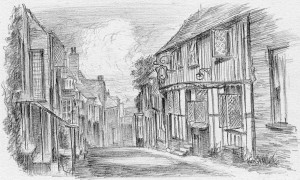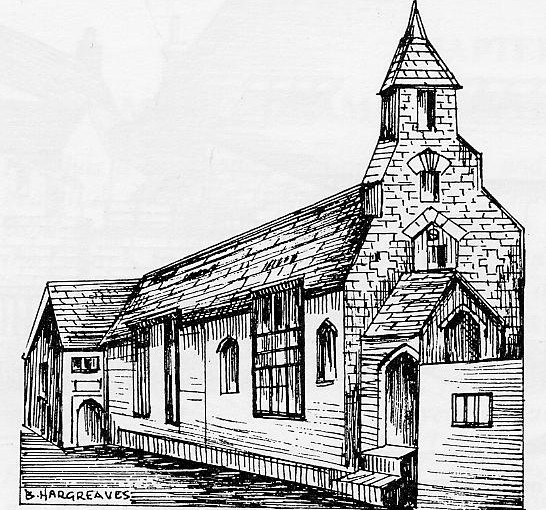By Noel C. A. Care.
More Buildings and Games.
There were other buildings which found their way into our games. Brought up, as we were, in a town full of old buildings, we took little notice of them unless they affected us.There were two in Mermaid Street that became, even if only by implication, part of our games. The Old Hospital was always where our wounded were taken after we had once more beaten off French invaders from either Ypres Tower or Landgate. Whether the hospital was built in those days did not worry us, and of course, we knew little of the medical treatment in those far off days.

When not fighting the French we were Smugglers, Revenue Men or Dragoons. Then the “Mermaid Inn” became the centre of our interest.
Although built much earlier, and had much in common with “St Anthony”, we knew it had connections with smugglers and so formed the centre for our games. The fact it was an interesting building, was of little importance. The fact we could run through it’s archway, where many a Victorian coach had gone, and across the yard. Then down the steps across a road and disappear through the “Needles” giving a quick exit from Mermaid Street when we heard “Get out of here you boys” was of great importance.
In our games, it must be admitted the “Goodies” were the smugglers who always won. We were not really interested in the law’s idea of right and wrong. After all we lived in smuggler country.
The other building that intrigued us, not for the building itself, but what must have gone on inside it. This was The Peacocke Grammar School. We often wondered what was learned and what the children that went there were like.
Changing Schools
After two years in the infants school I moved to what was know, colloquially, as the “Big Boys School”. Situated off Mermaid Street, boys went here from the age of seven, until leaving at fourteen. As we all started at the same time, having been together in the infants, there was not the same trauma as my first day at that school. The move up to this school was only made once a year and I found that I was by far the youngest in my class. We all had to sit in regimented rows, two to a desk to receive tuition. Although I did reasonably well at my lessons I was continually being told about my bad writing, I still am.
The first two years were spent in the same classroom with one teacher being expected to teach two classes at the same time. Ours was Mrs. Jenner who had a son in her other class. We thought she would favour him but she always seemed to be picking on him for not sitting still or something.
Teaching two classes by one teacher was done by giving one class reading, writing or arithmetic, whilst teaching the other class. As we could all read and write and do, as we said, our sums this presented no problem. In addition we had lessons in History and Geography with a few basic facts of Science. This usually revolved around people and their achievements. I recall these included “James Watt and steam” among others.
At the end of the year the older class moved to another classroom, and were replaced by the next intake. The previous young class now became the older class. Events stopped me from ever moving from the one classroom, although I understood the other classes had one teacher to each class.
The playground, to us newcomers, seemed very large. It was divided by a row of toilets which were bitterly cold in winter. I have many happy memories of the games we played. At playtime and before school, the air seemed to ring the sounds of excited boys bustling and jostling around, kicking balls, occasionally fighting, but ending the day as friends. I was to miss this companionship for a long time, when I was forced to move.
As if by unwritten agreement the older boys stayed in the lower, larger playground, whilst youngsters kept to the upper smaller. The games and activities were the same. Many boys brought balls of all sizes and these were the centre of many games. They were played with either alone, in pairs, or groups and the playground could be a confusing mass of boys and balls.
There was a certain code of honour among us. If a ball went astray to another part of the playground it was always returned to the owner. It would have been unthinkable to keep a ball belonging to someone else. They were very precious, as if one was lost our parents would not have been able to replace it easily. We took great care of them.
At one end of the playground was a high wall behind which was a large garden. Because of the slope of the land this was much higher than the playground. Sometimes tragedy would happen and a ball would sail over and was lost.
Every so often the old gardener would appear, with a bag of our lost balls, which he would throw one at a time into the playground, and a scramble would ensure for possession.
Often one or two boys would bring hoops, which were very popular. With an iron hook on a stick, they would trundled them around the edge of the playground, having already run with them from home. Boys hoops were always iron, wooden hoops were for girls or little boys of six and under.
In the autumn there were always conker contests. Several weekends were spent collecting our contenders. Lucky was the boy who knew where to find the biggest, he kept the secret well. We always needed a large supply at home, as, despite claims of “Mines a sixty twoer”, the playground was always littered with broken conkers. Further supplies were always prepared over night for the next days combats. Many a lad had difficulty writing at this time, because his hand and fingers had been hit so often by a miss aimed conker.
Another popular sport, at the right season, was tops. Boys always had peg tops which had a tendency to fly through the air if not struck properly. Most of us had whips made of a piece of wood and string, but a lucky few, which did not include me, had leather whips, often made of bootlaces from a working mans boot.
Girls tops were different from the peg tops we had. Ours were about an inch and a half high up to a spread out top, giving them the appearance of a tall mushroom. They came in many colours although dark green or brown seemed to predominate. Those used by the girls were far bigger round and almost the same thickness all the way up. They were far more stable than the peg tops with their tendency to fly through the air if hit incorrectly. Girls often used to colour the top with different chalks and watch the pattern change as it spun.
Whilst some boys happily knocked their tops around the playground on their own, others often engaged in team contests. One of these involved two equal teams facing each other, each boy with his whip. A top would be spun in the middle. The object was to propel it along the row to the opposite teams goal. If the teams were large two tops, would be used. This simple game would cause great excitement and noise. Fortunately most of us wore boots as the whips often lashed our ankles. For added protection we put cardboard down the side and front of our socks. Occasionally a whip would hit above the socks and as we all had short trousers this could be very painful.
Another way in which tops were played was what we called “Top Fights” and usually only played by older and bigger boys. In principle this was simple. Two boys started spinning their tops then took it in turns to try and knock the other top over with theirs. Soon turns became forgotten in a frenzy of whipping tops in the direction of your opponent and then arguments as to who knocked who over, particularly if they both fell down. Many times these games ended as real fights as those participating became more and more excited. The main interest seemed to come from the onlookers who encouraged one boy or the other with shouts.
All these games are now gone forever, forgotten by all but a few, and a far cry from the amusement of children today.
